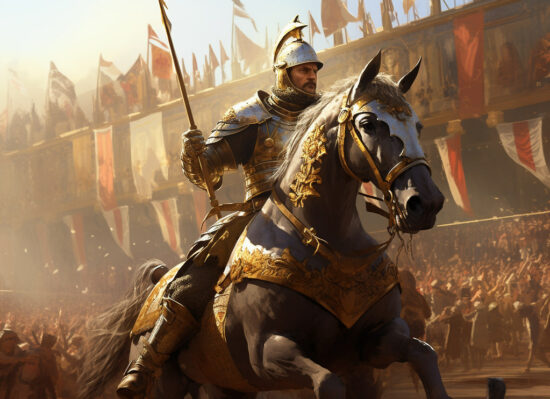Plot and Storyline
Sir Walter Scott published “Ivanhoe,” a historical novel, in 1819. Set in 12th-century England, the story takes place during the reign of Richard the Lionheart and explores themes of chivalry, honor, love, and identity. The plot revolves around the adventures of Wilfred of Ivanhoe, a disinherited knight, as he navigates the conflicts between Saxons and Normans and seeks to restore justice and reunite with his beloved Lady Rowena.
The novel begins with the return of Richard the Lionheart from the Crusades, but he is taken captive on his journey back to England. In Richard’s absence, Prince John assumes power and allows the Norman nobles to oppress the Saxon population. Ivanhoe, who has received his father’s disapproval for supporting Richard, disguises himself and competes in a tournament, winning the respect of many people—including his estranged father and King Richard, who the enigmatic Black Knight frees.
Ivanhoe falls in love with Lady Rowena, a beautiful Saxon noblewoman, but faces numerous obstacles in their relationship due to their different social statuses and the ongoing conflict between Normans and Saxons. Additionally, Rebecca, a Jewish healer, becomes a central figure in the story and develops a deep bond with Ivanhoe. The novel explores the complexities of love and loyalty amidst a backdrop of political unrest and cultural divisions.
As the story progresses, Ivanhoe finds himself caught in a series of dangerous situations, including confrontations with Templar knights and a siege at the castle of Torquilstone. Ultimately, Ivanhoe’s bravery and loyalty are tested as he fights to protect his loved ones and restore justice in a divided kingdom. The novel reaches its climax with the Battle of Athelstanford, where Ivanhoe and his allies face Prince John’s forces in a decisive conflict that determines the fate of England.
Characters
“Ivanhoe” features a rich cast of characters, each with their own motivations and contributions to the story. Wilfred of Ivanhoe serves as the novel’s protagonist, and his journey of self-discovery and redemption forms the backbone of the narrative. Ivanhoe is depicted as a noble and honorable knight who defies societal expectations and fights for justice, even when it means going against his own family.
Lady Rowena, Ivanhoe’s love interest, embodies the ideals of beauty and virtue, and her character highlights the social divisions and prejudices of the time. She represents the Saxon nobility and serves as a symbol of hope for the oppressed Saxons. Rebecca, the Jewish healer, is another significant character who challenges societal norms and stereotypes. She is portrayed as intelligent, compassionate, and morally upright, despite facing persecution due to her religious background.
Other notable characters include King Richard the Lionheart, who embodies the virtues of chivalry and inspires loyalty among his subjects. Prince John, on the other hand, represents the corrupting influence of power and serves as a foil to Richard. Additionally, there are memorable supporting characters such as Cedric the Saxon, Ivanhoe’s father; Gurth, a loyal Saxon servant; and the enigmatic Black Knight, whose identity is revealed later in the story.
Themes and Symbols
“Ivanhoe” explores several key themes that are central to the novel’s meaning and message. One of the main themes is the conflict between different cultures and social classes. The divide between Saxons and Normans serves as an exploration of racial and cultural tensions, with Scott highlighting the need for understanding and unity in a diverse society.
Another significant theme is the exploration of honor and chivalry. The novel presents a romanticized vision of the Middle Ages, where knights uphold a code of honor and engage in feats of bravery. Ivanhoe embodies these ideals, and his actions throughout the story reflect his commitment to honor, loyalty, and justice.
Religious and racial tolerance are also prominent themes in “Ivanhoe.” The character of Rebecca challenges the prejudices of the time, and her persecution as a Jew raises questions about the nature of prejudice and the importance of tolerance and acceptance.
Symbols are used throughout the novel to enhance its themes and meanings. The Black Knight, for example, symbolizes hidden identities and the potential for redemption. The tournament and jousting scenes symbolize the physical and moral challenges faced by the characters, as well as the spectacle and pageantry of medieval society.
Writing Style
Scott’s writing style in “Ivanhoe” is characterized by its richly descriptive language, detailed historical context, and use of archaic language to create an authentic medieval atmosphere. His prose is often poetic, evoking vivid imagery and immersing the reader in the world he portrays.
The author employs various literary techniques to enhance the narrative, such as the use of dialogue to reveal character traits and advance the plot. Scott also incorporates elements of romance, adventure, and suspense, keeping the reader engaged throughout the story. His ability to create memorable and multidimensional characters adds depth to the narrative, allowing readers to connect with the protagonists and understand their motivations.
The narrative structure of “Ivanhoe” is carefully crafted, with Scott blending historical events, political intrigue, and personal relationships seamlessly. The story unfolds through a series of interconnected episodes, each contributing to the overall plot and character development. Scott’s skillful pacing and ability to build tension keep readers invested in the outcome of the story.
Setting and Atmosphere
The setting of “Ivanhoe” is crucial to the story, as it takes place during a tumultuous period in English history. The novel is primarily set in medieval England, where the conflict between the Saxons and Normans creates a backdrop of political unrest and cultural divisions. Scott vividly describes the landscapes, castles, and towns, immersing readers in the sights, sounds, and smells of the time.
The atmospheric descriptions in the novel contribute to the overall tone and mood. The contrast between the grandeur of the castles and the poverty of the villages highlights the stark social inequalities of the era. The evocative descriptions of battles, tournaments, and courtly rituals add to the sense of adventure and excitement, while the scenes depicting the persecution of the Jews evoke a sense of injustice and sympathy.
Historical, Social, or Political Context
“Ivanhoe” was written at a time when there was a growing interest in medieval history and literature. Scott’s novel contributed to the revival of interest in the Middle Ages and played a significant role in shaping popular perceptions of the era. The novel reflects the author’s admiration for chivalry, honor, and the ideals of the past while also critiquing the social and political injustices of his own time.
The struggle for dominance between the Saxons and Normans in England during the 12th century serves as the novel’s historical context. Scott uses this historical backdrop to explore themes of identity, national pride, and the consequences of prejudice and discrimination.
Impact and Reception
“Ivanhoe” had a profound impact on literature and culture. It was widely popular upon its publication and remains one of Scott’s most celebrated works. The novel’s vivid characters, engaging plot, and exploration of timeless themes have ensured its enduring appeal.
“Ivanhoe” received critical acclaim for its historical accuracy, compelling storytelling, and vivid characterization. It was praised for its ability to transport readers to a bygone era while exploring universal themes that resonate with readers of all ages.
The novel’s success led to a surge of interest in historical fiction and influenced subsequent works in the genre. It also inspired adaptations in various forms, including stage plays, operas, and films, further cementing its cultural significance.
How did Sir Walter Scott’s “Ivanhoe” contribute to the romanticization of the Middle Ages?
Sir Walter Scott’s novel, “Ivanhoe,” played a significant role in the romanticization of the Middle Ages. Here’s how “Ivanhoe” contributed to the romanticization of the Middle Ages:
1. Chivalry and Code of Honor: “Ivanhoe” portrays chivalry as a central aspect of medieval society, emphasizing the knight’s code of honor, bravery, and loyalty. The novel’s protagonist, Ivanhoe, embodies these qualities, fighting for justice, defending the weak, and upholding his knightly ideals. By emphasizing chivalry, Scott romanticized the medieval knight as a noble and virtuous figure, capturing the imagination of readers.
2. Courtly Love and Romance: “Ivanhoe” explores the theme of courtly love, presenting idealized romantic relationships within a medieval context. The love triangle between Ivanhoe, Lady Rowena, and Rebecca epitomizes courtly love conventions, with themes of unrequited love, devotion, and the idealization of women. Scott’s portrayal of courtly love resonated with readers, contributing to the romanticized perception of medieval romance and ideals of love.
3. Medieval Setting and Atmosphere: Scott’s detailed descriptions of medieval settings, such as castles, tournaments, and forests, helped create an immersive and romanticized atmosphere. The novel’s vivid depiction of grand feasts, jousting tournaments, and majestic landscapes evoked a sense of nostalgia for a bygone era. This romanticized portrayal of the medieval world influenced subsequent works and popularized the notion of the Middle Ages as a time of adventure, heroism, and enchantment.
4. Heroic Characters and Epic Quests: “Ivanhoe” features heroic characters who embark on epic quests, further enhancing the romanticized image of the Middle Ages. Ivanhoe himself represents the archetypal hero who overcomes various challenges, confronts adversaries, and fights for noble causes. The novel’s emphasis on heroic deeds, quests for honor, and the triumph of good over evil aligns with the romantic tradition, fueling the idealized perception of the medieval era.
5. Idealized Historical Context: Scott presents a somewhat idealized historical context in “Ivanhoe,” emphasizing the virtues of the past while downplaying the harsh realities of medieval life. The novel highlights a sense of nostalgia for a golden age of knighthood, courtly love, and noble ideals. This idealization of the historical context contributes to the romanticized image of the Middle Ages, reinforcing the notion of a glorious and enchanting past.
Sources
Ivanhoe: Full Book Summary | SparkNotes
A Summary and Analysis of Sir Walter Scott’s Ivanhoe – Interesting Literature






